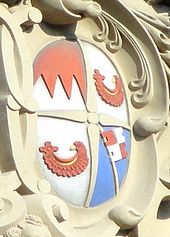Philipp Adolf von Ehrenberg

Philipp Adolf von Ehrenberg (born September 23, 1583 in Heinsheim , † July 16, 1631 in Würzburg ) was Prince-Bishop of Würzburg , counter-reformer and witch hunter from 1623 .
Live and act
Philipp Adolf came from the family of the Lords of Ehrenberg , whose ancestral seat was Ehrenberg Castle near Heinsheim am Neckar. His father Johann Heinrich von Ehrenberg († 1584) was married to Margarethe (February 4, 1549–1611), sister of the Prince-Bishop of Würzburg Julius Echter von Mespelbrunn since June 13, 1564 . On his father's tomb, Philipp Adolf is shown as one of eight children, alongside his parents and the Savior .
His uncle Julius Echter von Mespelbrunn had a decisive influence on the development of the young Philipp Adolf. After his older brother Peter von Ehrenberg renounced his church benefices , Philipp Adolf entered the clergy. He was elected Prince-Bishop of Würzburg on February 6, 1623, and the election was confirmed by Pope Urban VIII on March 19, 1624 .
At the end of his life he published a Catholic hymn book under the title Alte und Newe Geistliche Catholische Auslesene Gesängle .
Witch trials
Prince-Bishop Philipp Adolf von Ehrenberg pursued a tough policy of recatholization . At the same time, his name is linked to the witch trials in Würzburg , which reached their peak between 1626 and 1630. More than 900 alleged witches were burned in the monastery , around 200 in the city of Würzburg alone. In Gerolzhofen , Würzburg , incinerators were installed to burn the many people every year. The witch hunt affected people of all classes: nobles, councilors and mayors were burned next to ordinary people. 20 percent of those burned in Würzburg were priests and religious.
The numerous persecutions of witches in the Würzburg monastery were not interrupted until the Imperial Court of Justice and the Prince-Bishop's death on July 16, 1631, and ended in 1749 with the judicial murder of the nun Maria Renata Singer von Mossau .
Tomb
His baroque tomb, created by Johann Philipp Preuss from 1667 to 1669 (about seven meters high and about 2.6 meters wide), he received in Würzburg Cathedral , originally on a nave pillar and after the collapse of the northern main nave wall in 1946 and the incomplete reconstruction in north aisle.
literature
- Ronny Baier: Philipp Adolf von Ehrenberg. In: Biographisch-Bibliographisches Kirchenlexikon (BBKL). Volume 24, Bautz, Nordhausen 2005, ISBN 3-88309-247-9 , Sp. 545-549.
- Kurt Baschwitz: Witches and witch trials. Bertelsmann, Munich 1990, pp. 260-266.
- Hans-Wolfgang Bergerhausen: Philipp Adolf von Ehrenberg. In: New German Biography (NDB). Volume 20, Duncker & Humblot, Berlin 2001, ISBN 3-428-00201-6 , p. 387 f. ( Digitized version ).
- Ralph Kloos, Thomas Göltl: The witch burners of Franconia . Erfurt 2012. ISBN 978-3-95400-109-5 .
- Robert Meier: witch trials in the Würzburg monastery. From Julius Echter (1573–1617) to Philipp von Ehrenberg (1624–1631) . Echter, Würzburg 2019, ISBN 978-3-429-05382-6 .
- Stephan Oettermann : History of the witch burning in Franconia (especially in Gerolzhofen) in the 17th century.
- Harald Schwillus: The witch trials against Würzburg clergy under Prince Bishop Philipp Adolf von Ehrenberg (1623–1631) . Echter, Würzburg 1998, ISBN 3-429-01229-5 .
- Winfried Romberg (edit.): The Würzburg bishops from 1617 to 1684 (= Germania Sacra. Third series 4. The dioceses of the ecclesiastical province of Mainz. The diocese of Würzburg; 7). De Gruyter, Berlin 2011, ISBN 978-3-11-025183-8
Web links
Individual evidence
- ↑ Stefan Kummer : Architecture and fine arts from the beginnings of the Renaissance to the end of the Baroque. In: Ulrich Wagner (Hrsg.): History of the city of Würzburg. 4 volumes; Volume 2: From the Peasants' War in 1525 to the transition to the Kingdom of Bavaria in 1814. Theiss, Stuttgart 2004, ISBN 3-8062-1477-8 , pp. 576–678 and 942–952, here: pp. 622–624.
| predecessor | Office | successor |
|---|---|---|
| Johann Gottfried von Aschhausen |
Prince-Bishop of Würzburg 1623–1631 |
Franz von Hatzfeld |
| personal data | |
|---|---|
| SURNAME | Ehrenberg, Philipp Adolf von |
| BRIEF DESCRIPTION | Prince-Bishop of Würzburg |
| DATE OF BIRTH | September 23, 1583 |
| PLACE OF BIRTH | Heinsheim |
| DATE OF DEATH | July 16, 1631 |
| Place of death | Wurzburg |
